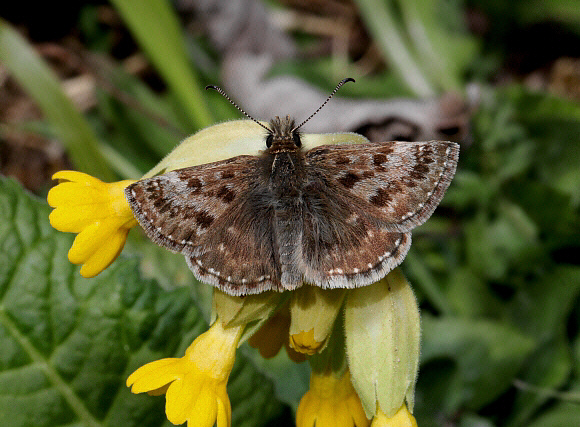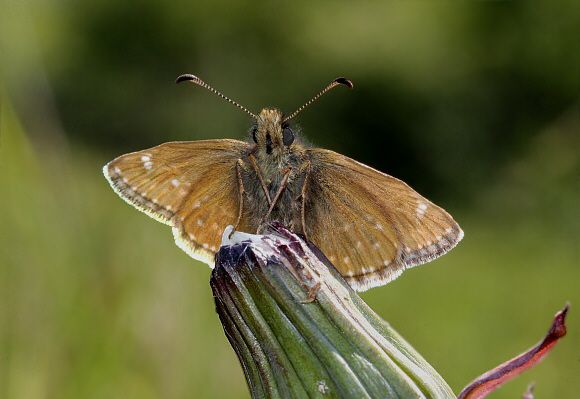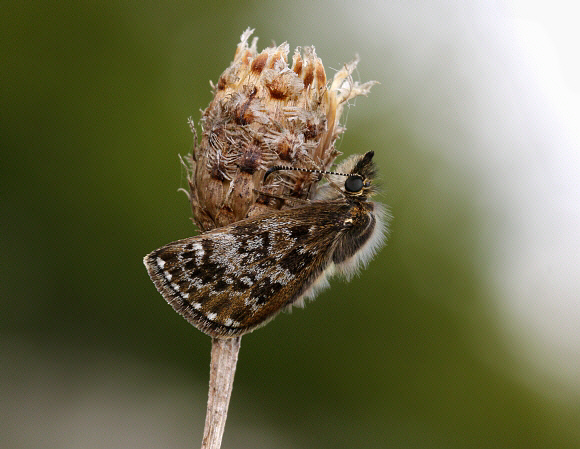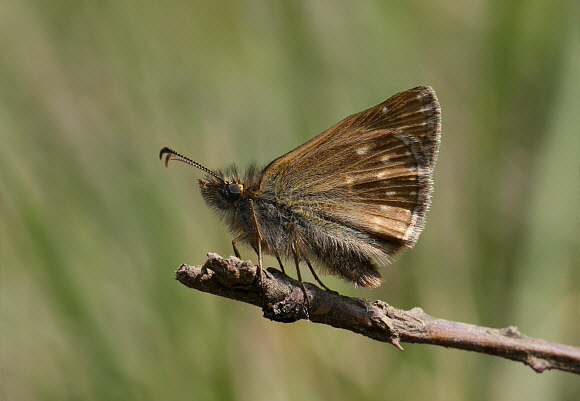 Dingy Skipper Erynnis tages, copulating pair, Cerne Abbas, Dorset – Adrian Hoskins
Dingy Skipper Erynnis tages, copulating pair, Cerne Abbas, Dorset – Adrian Hoskins
Introduction
Despite it’s rather unflattering vernacular name, this is a lovely insect, worthy of much greater attention than it generally attracts. Old faded butterflies may indeed be a little dingy, but a freshly emerged Dingy Skipper shows itself to be beautifully marked in subtle shades of brown and grey.
The butterfly is quite variable in appearance, populations in woodlands tending to be darker and more strongly marked, compared with the pallid specimens which predominate on chalk landslips, quarries and limestone pavements. Males are duller and more unicolorous, and have a pronounced fold on the leading edge of the forewings. This fold has special wing-scales called androconia that disseminate pheromones, and are used to entice females during courtship.
 Dingy Skipper Erynnis tages, male, Noar Hill, Hampshire – Adrian Hoskins
Dingy Skipper Erynnis tages, male, Noar Hill, Hampshire – Adrian Hoskins
The Dingy Skipper is distributed throughout most of Europe but is absent from northern Scandinavia and most of the Mediterranean islands. There are several other members of the genus found in temperate Asia, North America, and the Andes.
There are no similar species in Britain, but in Turkey, Greece and Albania the butterfly shares it’s habitats and emergence time with a similar species Erynnis marloyi. The latter is distinguished by being darker and much plainer than stages.
Habitat
The Dingy Skipper is localised throughout England and Wales, preferring well drained, lightly grazed dry grassy habitats where the larval foodplant bird’s foot trefoil grows in profusion.
It favours a warm sunny environment with small but profuse patches of bare ground such as those created by cattle poaching or by the erosion of small coombes. Typical habitats include calcareous grassland slopes, undercliffs, coastal landslips, dunes, abandoned quarries, grassy heaths, railway cuttings, spoil heaps, limestone pavements, and woodland clearings.
In Scotland and northern England it is primarily a coastal species, breeding on cliff-tops, shingle banks and sand dunes.
Most colonies are small and very localised – a typical colony will comprise of between 30-50 adults, although the numbers seen on any particular day are usually much lower. The largest known colony, on a stretch of undercliff in Dorset, probably holds about 200-300 adults at peak season.
 Dingy Skipper Erynnis tages, male, Cerne Abbas, Dorset – Adrian Hoskins
Dingy Skipper Erynnis tages, male, Cerne Abbas, Dorset – Adrian Hoskins
Lifecycle
The butterflies are normally single brooded in Britain, emerging in May, although at the warmest sites in southern England there may occasionally be a partial second brood in late July or early August. In southern Europe there is usually a partial or complete second brood emergence in July.
| In 2007, a very hot and early spring was followed by the dullest and wettest British summer for 280 years. It was expected under such conditions that the 2nd brood would be at best partial or fail to materialise at all. However an almost complete 2nd brood emergence occurred at Ballard Down in Dorset in late July. Dingy Skipper larvae are nocturnal feeders, and in overcast weather night time temperatures are higher, so they were able to develop quickly and produce a second generation of adults. |
 Dingy Skipper Erynnis tages, female at roost, Butser Hill, Hampshire � Adrian HoskinsThe strongly ribbed eggs are laid singly on the upper surface of leaflets of bird’s foot trefoil Lotus corniculatus, or less commonly on greater bird’s foot trefoil L. uliginosus. At some sites e.g. Ballard Down in Dorset, horseshoe vetch Hippocrepis comosa is usually chosen despite a profusion of bird’s foot trefoil. The eggs are pale yellowish-green when first laid but turn bright orange after 4 days, and hatch about 12 days after being laid.
Dingy Skipper Erynnis tages, female at roost, Butser Hill, Hampshire � Adrian HoskinsThe strongly ribbed eggs are laid singly on the upper surface of leaflets of bird’s foot trefoil Lotus corniculatus, or less commonly on greater bird’s foot trefoil L. uliginosus. At some sites e.g. Ballard Down in Dorset, horseshoe vetch Hippocrepis comosa is usually chosen despite a profusion of bird’s foot trefoil. The eggs are pale yellowish-green when first laid but turn bright orange after 4 days, and hatch about 12 days after being laid.
During daylight hours the larva lives within a loose tent of leaves spun together at the base of the foodplant, and emerges to feed more openly in the early evening. When fully grown it is yellowish green, faintly marked with a dark line along the back, and pale lines along the sides. The head is brown, with dark purplish-black markings.
By early August the larva is almost fully grown, and at this point it enters hibernation, over-wintering within a thin silk tent. It remains inside this hibernaculum until April, when it pupates. Gently pulling apart the silk tent reveals the shiny pupa, which has dark green wing cases and a brown abdomen.
Adult behaviour
On warm but overcast days in late April and May, the butterflies bask with wings held flat, on bare soil, stones or low herbage.
In sunny conditions they are very active, zipping and whirring about, usually no more than a few inches above the ground; stopping occasionally to bask for a moment or two on a grass head, or to nectar at their favourite wild flowers – bird’s foot trefoil, common vetch, horseshoe vetch, buttercups, ground ivy, cranesbills, speedwells and bugle.
Dingy Skippers generally hold the wings flat when nectaring, but in warm weather they raise them at an angle of about 45 degrees, or sometimes if very warm they hold the wings erect.

Dingy Skipper Erynnis tages, male perching, Bentley Wood, Hampshire – Adrian Hoskins
When male Dingy Skippers encounter each other a sortie takes place, with both butterflies whirling about in tight circles close to the ground, occasionally making physical contact. After about a minute the pair suddenly rocket skyward to a height of about 3 metres, at which point the intruding male is chased off, and the original occupant of the territory returns to continue search of a female.
Copulation takes place mid-late morning, at a sheltered spot, typically at the base of a hill. During copulation both sexes spread their wings flat.

Dingy Skipper Erynnis tages, female at roost on knapweed, Noar Hill, Hampshire – Adrian Hoskins
As evening approaches, Dingy Skippers migrate to the last remaining sunlit spots in their habitat. There they settle to bask on grass heads, or more often on the dead flower heads of knapweeds or St Johns wort. As the temperature drops, and the last rays of sunshine fade, they adjust their position, wrapping their wings tightly around the flower heads, upon which they roost overnight.
During extended periods of inclement weather, Dingy Skippers can aestivate for long periods – on 14th May 2006 I found a pristine and distinctively marked female, roosting at dusk on a dead knapweed flower head at Noar Hill in Hampshire. That night the weather suddenly deteriorated, and it remained wet and windy for the next 2 weeks. I returned on 27th May and was surprised to find the butterfly still alive, and still at roost on the same flower head, from which it had been unable to move in the intervening period.
